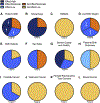Systematic review of the association between oil and natural gas extraction processes and human reproduction
- PMID: 27568524
- PMCID: PMC7528095
- DOI: 10.1016/j.fertnstert.2016.07.1099
Systematic review of the association between oil and natural gas extraction processes and human reproduction
Abstract
This systematic review identified 45 original published research articles related to oil and gas extraction activities and human reproductive endpoints. Reproductive outcomes were categorized as [1] birth outcomes associated with maternal exposure, [2] semen quality, fertility, and birth outcomes associated with adult paternal exposure, [3] reproductive cancers, and [4] disruption of human sex steroid hormone receptors. The results indicate there is moderate evidence for an increased risk of preterm birth, miscarriage, birth defects, decreased semen quality, and prostate cancer. The quality of the evidence is low and/or inadequate for stillbirth, sex ratio, and birth outcomes associated with paternal exposure, and testicular cancer, female reproductive tract cancers, and breast cancer, and the evidence is inconsistent for an increased risk of low birth weight; therefore, no conclusions can be drawn for these health effects. There is ample evidence for disruption of the estrogen, androgen, and progesterone receptors by oil and gas chemicals, which provides a mechanistic rationale for how exposure to oil and gas activities may increase the health risks we have outlined. The results from this systematic review suggest there is a negative impact on human reproduction from exposure to oil and gas activities. Many of the 45 studies reviewed identified potential human health effects. Most of these studies focused on conventional oil and gas activities. Few studies have been conducted to evaluate the impact of unconventional oil and gas operations on human health. The impact of unconventional oil and gas activities may be greater than that of conventional activity, given that unconventional activities employ many of the same approaches and use dozens of known endocrine-disrupting chemicals in hydraulic fracturing.
Keywords: Birth defects; cancer; endocrine disrupting chemicals; environmental pollution; fracking; hormonal activity; human reproduction; hydraulic fracturing; oil and natural gas; prenatal exposure; preterm birth; semen quality.
Copyright © 2016. Published by Elsevier Inc.
Figures



References
-
- U.S. Energy Information Administration. Monthly crude oil and natural gas production. Washington, DC: U.S. Department of Energy; 2016. Available at: http://www.eia.gov/petroleum/production/. Accessed August 17, 2016.
-
- U.S. Energy Information Administration. Annual energy outlook 2016 with projections to 2040. Washington, DC: U.S. Department of Energy; 2016. Available at: http://www.eia.gov/forecasts/aeo/index.cfm. Accessed August 17, 2016.
-
- U.S. Energy Information Administration. Number of producing gas wells. Washington, DC: U.S. Department of Energy; 2016. Available at: https://www.eia.gov/dnav/ng/ng_prod_wells_s1_a.htm. Accessed August 17, 2016.
-
- Colborn T, Schultz K, Herrick L, Kwiatkowski C. An exploratory study of air quality near natural gas operations. Hum Ecol Risk Assess 2014;20:86–105.
Publication types
MeSH terms
Substances
Grants and funding
LinkOut - more resources
Full Text Sources
Other Literature Sources

